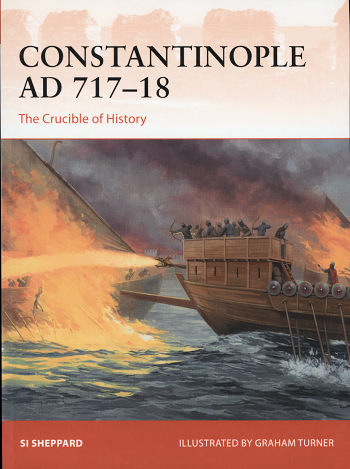Osprey's Constantinople
717-718
|
Author: |
Si Sheppard |
|
Publisher/Distributor |
Osprey Publishing |
|
Price |
$24.00 MSRP |
|
Reviewer: |
Scott Van Aken
|
|
Notes: |
96 pages, 7¼ x 9¼ inches, softcover
ISBN: 978-1-4728-3692-2 |
 There
are are probably no event or sequence of events that could be considered
pivotal. However, one of them has to be the sieges of Constantinople in the
early 8th Century. The Byzantine empire was at a point of shrinking due to
incessant attacks and invasions by Islamic forces.
There
are are probably no event or sequence of events that could be considered
pivotal. However, one of them has to be the sieges of Constantinople in the
early 8th Century. The Byzantine empire was at a point of shrinking due to
incessant attacks and invasions by Islamic forces.
In 610 the Islamic Prophet Muhammad began receiving
what Muslims consider to be divine revelations.
These concepts drew a large number of people to accept these as a way of life
and by the time of Muhammad's death in 632, there were a considerable number of
influential leaders who had fully embraced Islam. These men were spurred to
begin a program of conquest to bring Islam to the infidels and to unite the
world under one religion.
While many areas embraced Islam, it wasn't the case everywhere these armies went
and one place was Christian Byzantium. Especially in those days, religion was
power and a main way to control the masses. Islam eventually took over much of
North Africa and into the Iberian peninsula in a remarkably short time. However,
the Byzantine empire, such as it was, became a major block.
Byzantium had several major factors
going for it. One was the Tarsus mountains in eastern Anatolia. It was a rugged
line with few passes and was easily defended. Another was that Constantinople
itself was heavily fortified and nigh impregnable at the time. The Byzantine
fleet also had a terrible weapon in what is known as Greek Fire. This concoction
is very much like napalm and once it hits you, cannot be extinguished, even by
immersion in water.
However, the caliphs were determined and for decades
were able to eventually get past the mountains and up to the eastern side of the
Dardanelles, where they set up siege weapons and gathered their troops. Not
surprisingly, they were stymied in most of their attempts to land troops and
supplies by sea near Constantinople by Greek Fire, and eventually, even their
biggest and most successful campaigns were forced back by Anatolian winters,
which can be quite harsh.
As we all know Constantinople was finally to succumb in
the 15th Century, but it did not happen earlier. So why is the last major
attempt in 717/8 considered pivotal? Had the Muslims succeeded, they would have
had an open way into the rest of the Balkans and eventually into Europe. This
would have driven Christianity to near extinction and made the world a very
different place than what it is now.
The author had done an outstanding job of telling not
only the tale of all the events leading up to the pivotal siege, but also of the
siege itself. He also provides us with a look at how it affected the world order
and what could have been if it had succeeded. The book includes not only great
maps, but some super period art work and photos of many of the areas as they
look today. It is one into which one can easily become immersed and tells a
story of which few are truly aware. It is a book that I can most highly
recommend to history buffs.
February 2020
Copyright ModelingMadness.com. All rights reserved.
For more on the complete line of Osprey books,
visit www.ospreypublishing.com .
If you would like your product reviewed fairly and quickly, please
contact
me or see other details in the
Note to
Contributors.
 There
are are probably no event or sequence of events that could be considered
pivotal. However, one of them has to be the sieges of Constantinople in the
early 8th Century. The Byzantine empire was at a point of shrinking due to
incessant attacks and invasions by Islamic forces.
There
are are probably no event or sequence of events that could be considered
pivotal. However, one of them has to be the sieges of Constantinople in the
early 8th Century. The Byzantine empire was at a point of shrinking due to
incessant attacks and invasions by Islamic forces.